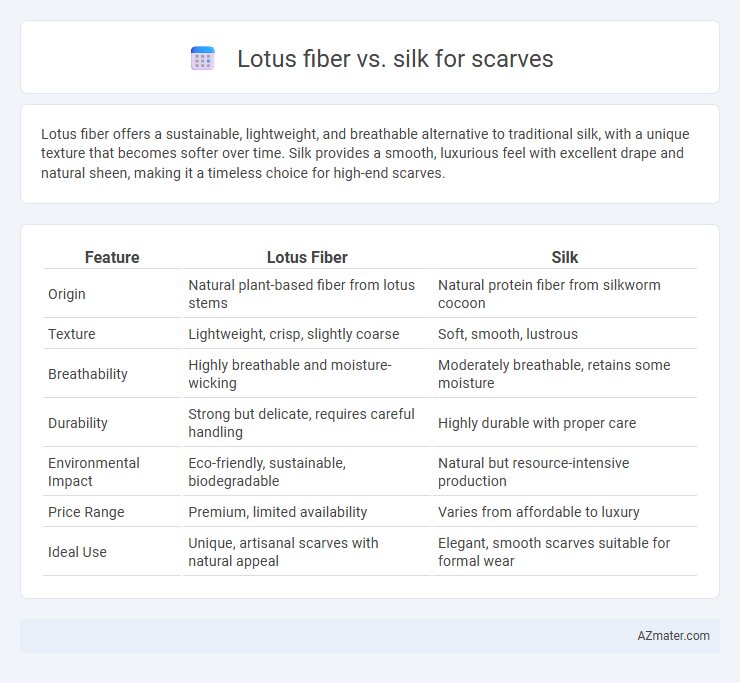Lotus fiber offers a sustainable, lightweight, and breathable alternative to traditional silk, with a unique texture that becomes softer over time. Silk provides a smooth, luxurious feel with excellent drape and natural sheen, making it a timeless choice for high-end scarves.
Table of Comparison
| Feature | Lotus Fiber | Silk |
|---|---|---|
| Origin | Natural plant-based fiber from lotus stems | Natural protein fiber from silkworm cocoon |
| Texture | Lightweight, crisp, slightly coarse | Soft, smooth, lustrous |
| Breathability | Highly breathable and moisture-wicking | Moderately breathable, retains some moisture |
| Durability | Strong but delicate, requires careful handling | Highly durable with proper care |
| Environmental Impact | Eco-friendly, sustainable, biodegradable | Natural but resource-intensive production |
| Price Range | Premium, limited availability | Varies from affordable to luxury |
| Ideal Use | Unique, artisanal scarves with natural appeal | Elegant, smooth scarves suitable for formal wear |
Introduction to Lotus Fiber and Silk Scarves
Lotus fiber scarves are crafted from natural fibers derived from lotus stems, known for their softness, breathability, and eco-friendly production process, making them a sustainable alternative to traditional fabrics. Silk scarves, made from the protein fibers produced by silkworms, offer a luxurious texture, natural sheen, and excellent durability, widely appreciated for their elegance and smooth feel. Both Lotus fiber and silk scarves provide unique tactile experiences and aesthetic appeal, catering to different preferences in sustainability and luxury.
Origin and Production Processes
Lotus fiber, derived from the stalks of the lotus plant primarily in Myanmar and Thailand, undergoes a labor-intensive extraction process involving hand-harvesting, soaking, and meticulous fiber separation to produce a lightweight, breathable fabric. Silk, sourced from silkworm cocoons predominantly in China and India, is created through sericulture where the cocoons are carefully boiled to extract fine threads that are spun into smooth, lustrous yarn. The natural, eco-friendly production of lotus fiber contrasts with silk's more standardized sericulture and reeling methods, influencing the texture and sustainability profiles of scarves made from these materials.
Material Composition and Properties
Lotus fiber, derived from the stems of lotus plants, offers a lightweight, breathable texture with natural moisture-wicking and hypoallergenic properties, making it ideal for sensitive skin. Silk, produced from silkworm cocoons, features a smooth, lustrous surface with high tensile strength and excellent thermal regulation, providing warmth without overheating. Both fibers excel in durability and comfort, but lotus fiber's eco-friendly cultivation contrasts with silk's resource-intensive production process.
Sustainability and Environmental Impact
Lotus fiber is highly sustainable, harvested from lotus stems without harming the plant, making it biodegradable and eco-friendly compared to traditional silk production. Silk involves sericulture, which requires significant water, energy, and often the killing of silkworms, raising ethical and environmental concerns. Choosing lotus fiber scarves reduces ecological footprint by supporting renewable resources and minimizing pollution associated with conventional silk farming.
Texture and Comfort
Lotus fiber offers a unique texture that is soft yet slightly coarse, providing a natural, earthy feel that is breathable and lightweight, ideal for warm climates. Silk scarves boast an incredibly smooth and luxurious texture characterized by a glossy sheen and exceptional softness, enhancing comfort by regulating temperature and feeling gentle against the skin. While lotus fiber excels in durability and eco-friendliness, silk remains unmatched in its silky touch and elegant drape, making both materials desirable for different comfort preferences.
Breathability and All-Season Wear
Lotus fiber offers exceptional breathability due to its natural hollow structure, which enhances air circulation and moisture wicking, making it ideal for all-season wear. Silk, while smooth and lightweight, tends to retain heat more than lotus fiber, making it less breathable in hot climates but suitable for cooler temperatures. Both fibers provide luxury and comfort, yet lotus fiber's superior ventilation makes it a preferred choice for scarves designed for versatility across varied weather conditions.
Durability and Longevity
Lotus fiber offers remarkable durability due to its natural strength and resistance to wear, making it an excellent choice for long-lasting scarves. Compared to silk, which is delicate and prone to snags and fading, lotus fiber maintains its integrity and color retention over time. Choosing a lotus fiber scarf ensures greater longevity and sustained aesthetic appeal with minimal care.
Color Vibrancy and Dyeing Techniques
Lotus fiber scarves exhibit exceptional color vibrancy due to their natural absorbency and smooth texture, which allows dyes to penetrate deeply without fading over time. In contrast, silk scarves, known for their luxurious sheen, require refined dyeing techniques like acid dyes or digital printing to achieve bright, lasting hues. Both materials respond differently to dyes, with lotus fiber providing a matte finish ideal for earthy tones, while silk offers a luminous surface enhancing jewel-toned colors.
Care and Maintenance Requirements
Lotus fiber scarves require gentle hand washing with mild detergent and air drying to maintain their natural texture and durability. Silk scarves demand even more delicate care, typically involving cold water hand washing or professional dry cleaning to preserve their lustrous sheen and prevent fabric damage. Both fibers benefit from storing in a cool, dry place away from direct sunlight to avoid color fading and fiber weakening.
Price Comparison and Accessibility
Lotus fiber scarves are generally more expensive than silk due to the labor-intensive harvesting process and limited production, making them a luxury item with restricted availability. Silk scarves are more affordable and widely accessible due to established mass production and extensive global supply chains. Consumers prioritizing budget and easy purchase typically opt for silk, while those seeking exclusivity and sustainability prefer lotus fiber despite the higher cost.

Infographic: Lotus fiber vs Silk for Scarf
 azmater.com
azmater.com